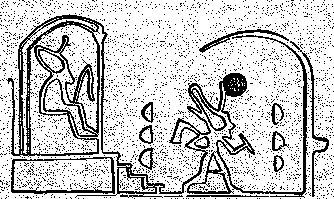6. But Metoro never mentioned Tauono. Instead, he usually said maitaki at the glyph type which possibly represents 3 islets and 3 mountain tops:
The positive values associated with the word maitaki could on Easter Island have signified the season when Sun is born in winter (or possibly in spring). The heliacally rising night sky is shining pleasantly at this time of the year:
Metoro did say matariki a few times when seeing a glyph type resembling maitaki:
I labelled the glyph type inoino instead of matariki, though, because Metoro preferentially used that word rather than matariki.
Both matariki and inoino are indicating something which is positively loaded. The double ino-ino is evidently another example of how twice means turning it into its opposite:
In all there are 12 instances when Metoro said te matariki, 11 of them accumulated in lines 5-6 on side b of Tahua and the last one in line 4 on side a:
Aa4-69 is special, not only because of its location but also because of its bad shape. We can count 46 * 9 (both numbers indicating 'death') = 414 = one more than 14 * 29.5. Maybe the inoino glyph type refers to Matariki i raro and the maitaki glyph type to Matariki i nika:
30 years between the Sed festivals could mean 3 decades which each was depicted by a 'ball' of the maitaki type:
3 * 5 = 15 years at left and 3 * 5 = 15 years at right. The pharaoh could have personified Sun, and on Easter Island Spring Sun could have ruled for 3 * 60 = 180 days. The Pleiades were rising 'almost simultaneous with the Austral June solstice' and maybe 180 days of Sun rule would follow. The inoino glyph type could symbolize 3 * 59 = 177 nights from midsummer to midwinter. The rhombs presumably represent the square fields of earth (in contrast to the 'eye with straw' sky symbols of maitaki). Alternatively the inoino glyph type could e.g. symbolize 3 * 64 = 192 days (half 364): ... It symbolizes: the pall which covers the dead, with its eight strips of black and white squares representing the multiplication of the eight of human families; the façade of the large house with its eighty niches, home of the ancestors; the cultivated fields, patterned like the pall; the villages with streets like seams, and more generally all regions inhabited, cleared or exploited by men. The chequer-board and the covering both portray the eight ancestors ... Nga Kope Ririva is probably corresponding to where the Moon year was beginning, i.e. when in the early night Matariki reappeared 'up above', and by contrast Teatea could then be located where the next (2nd) season was beginning, the inoino season. Tauono could refer to Nga Kope Ririva + Teatea, signifying the whole Matariki cycle. |
||||||||||||||||||||||||||||||||||||||||||||||||||||||||||||



